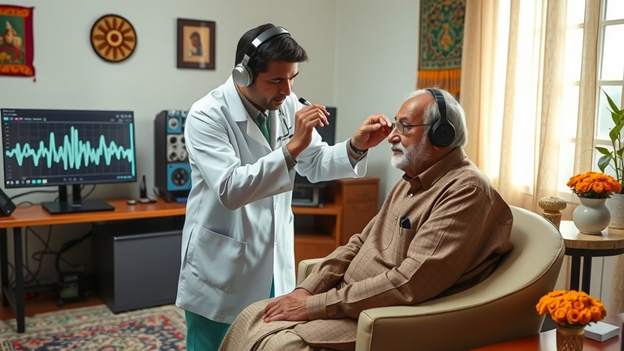Hearing is a crucial part of how we interact with the world. Sinusoidal audiometry, often known as pure-tone testing, helps in assessing this vital sense. It’s pivotal in understanding one’s hearing abilities and ensuring overall well-being. Regular hearing assessments might appear less important than other health checks, but they play a significant role in maintaining a healthy lifestyle. These assessments help detect potential issues early, offering a chance for effective intervention. Assessing your hearing health ensures you’re not missing out on life’s important auditory moments. In India, you can find various centers offering sinusoidal audiometry, which is an invaluable tool in hearing care. Taking these tests can enhance your quality of life by addressing issues before they become severe.
The Basics of Sound and Hearing
Understanding sound and hearing can be fascinating. Sound travels through your ear, from the outer ear, through the middle ear, and finally reaches the brain. This journey enables you to perceive and understand sounds around you. Sound has crucial features, like frequency and intensity. Frequency refers to how high or low a sound is, while intensity measures how loud it is. By grasping these concepts, you lay the foundation for understanding hearing tests, including sinusoidal audiometry. Hearing isn’t just picking up sounds; it involves interpreting these sounds so they make sense to you. Regular check-ups can help keep this complex system in check.
What is Sinusoidal Audiometry?
Sinusoidal audiometry is a key method used by professionals to evaluate hearing. This process involves testing an individual’s hearing thresholds using pure tones. But what are pure tones? They’re simply sounds at a single frequency, without any additional noise or overtones. This clarity is crucial in assessing specific frequency responses of an individual’s ears. These tests help pinpoint which frequencies you might struggle to hear, providing a clearer picture of any hearing issues. Pure tones used in sinusoidal audiometry are integral to this process. They help in diagnosing problems that specifically relate to individual frequencies, ensuring targeted approaches for solutions.
Steps in the Sinusoidal Audiometry Test
Ever wondered how a sinusoidal audiometry test works? The process is designed to be simple and efficient:
- Setup: You sit in a soundproof room with headphones.
- Test: Different pure tones are played, and you indicate when you hear them.
During the test, you might be asked to press a button or raise your hand whenever you hear a tone. This part of the test helps in mapping out the sounds you can and cannot hear. The test usually takes just a few minutes, offering quick insights into your hearing health. Following the instructions and interacting as directed are crucial to getting accurate results. Sinusoidal audiometry allows for a precise understanding of your hearing range.
How to Read an Audiogram?
After your test, you receive an audiogram. This chart graphically represents your hearing abilities. On the audiogram:
– Horizontal Axis: Shows the frequency or pitch of sounds.
– Vertical Axis: Indicates the intensity or loudness of sounds.
The plotted results show your hearing threshold at various frequencies. Reading this isn’t as complex as it seems. The Pure Tone Average (PTA) is a key element that represents your average hearing ability across tested frequencies. Understanding an audiogram helps you and your healthcare provider determine any hearing issues you may have.
Deciphering Audiometry Results: What They Mean for You
When you look at your audiometry results, they tell a story about your hearing. Hearing levels can range from normal to profound loss, and these results pinpoint where you stand. Sinusoidal audiometry can highlight different types of hearing loss, including conductive and sensorineural types. These results guide possible treatments, ranging from hearing aids to specific therapies. Understanding your results is the first step in taking control of your hearing health and making informed decisions about your care.
The Technological Advances in Sinusoidal Audiometry
Thanks to technology, sinusoidal audiometry is now more precise and reliable than ever. Modern techniques have improved the accuracy of assessments, ensuring that any issues are detected early. These advancements mean assessments aren’t just faster, but also more comfortable for patients. With technology, audiology professionals can offer enhanced care, resulting in better hearing outcomes. There are always new innovations that help improve the precision of hearing tests.
Pre-Test Preparation and Post-Test Steps
Preparing for a sinusoidal audiometry test is straightforward. On the day of the test, keep your ears clean and avoid loud noises beforehand. After receiving your results, discuss them with a healthcare professional. If further testing or treatments are advised, follow through promptly. Understanding the steps before and after your assessment helps ensure a smooth process and aids in better hearing health outcomes.
Conclusion and Call to Action
Caring for your hearing health is vital. Understanding how sinusoidal audiometry works can make managing your hearing easier and more effective. Early assessments mean you can catch issues before they turn serious, maintaining a good quality of life. In India, many facilities are equipped to offer these tests. Don’t wait for hearing problems to disrupt your life. Take action now and schedule your hearing test today for a future filled with clear sounds and vibrant interactions.



